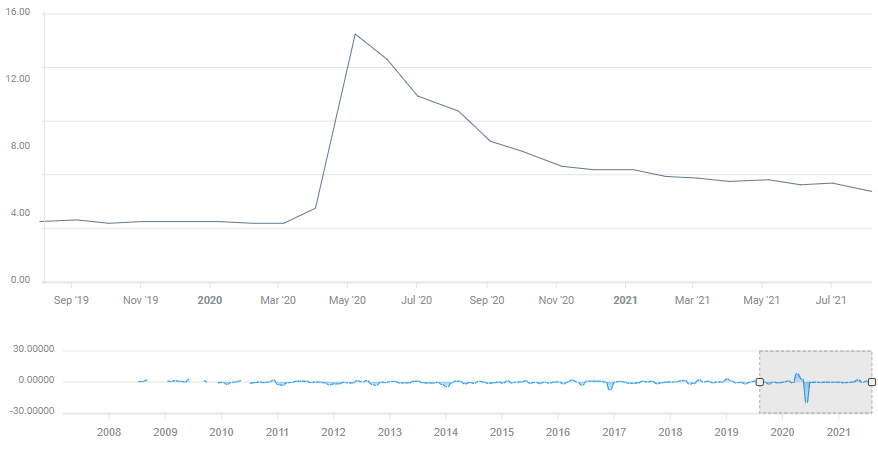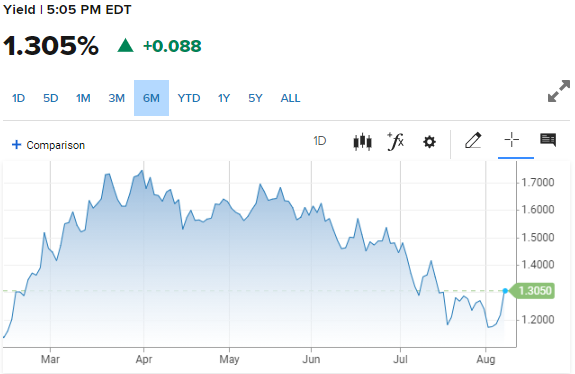- Nonfarm Payrolls rise 943,000 in July, revisions add 31,000 in May and 88,000 in June.
- Unemployment Rate falls to 5.4%, underemployment to 9.2%.
- Treasury yields, the dollar and stocks levitate, Dow, S&P 500 at records.
- Federal Reserve comments on bond taper appear prescient.
Hiring in the US has nearly doubled in the last two months in spite of fears of a resurgent pandemic and constraints from one of the tightest job markets in a generation.
Nonfarm Payrolls (NFP) added 943,000 workers in July, beating the 870,000 forecast and June’s total was revised up to 938,000, according to the Labor Department on Friday. Together the average of 940,500 was just shy of twice of the 487,400 monthly total from January to May.
Nonfarm Payrolls
The unemployment rate fell to 5.4% in July from 5.9% in June, also far better than the 5.7% prediction. The so-called underemployment rate, which includes discouraged workers, dropped to 9.2% from 9.8% in June. It has been expected to rise to 10%.
Unemployment Rate (U-3)
The decline in the unemployment rate was even more telling as the Labor Force Participation rate moved up to 61.7%, matching the pandemic high of March 2020, as more people left the jobless rolls and entered the workforce.
Average Hourly Earnings rose 0.4% on the month and 4% for the year, both more than forecast, and kept concerns about labor shortages prompting wage inflation active.
Over the past two months a number of states have eliminated the additional unemployment benefits granted by Washington, which may have contributed to the surge in hiring.
Markets were buoyed by the excellent report. The Dow rose144.26 points to 35,208.51, and the S&P 500 added 7.42 points to 4.436.52, both new records.
For the time being at least, stocks do not appear perturbed by the prospect of higher interest rates. One reason is the extremely low starting point for any increase generated from a sell-off in the Treasury market. Over the past four months the 10-year yield has shed 53 basis points from its high of 1.746 on March 31 to close at 1.217% on Thursday. A second reason is the Fed is determined to prevent a repeat of the 2013 'taper tantrum' which sent US interest rates skyrocketing.
The dollar climbed in all major pairs. The EUR/USD closed at 1.1763, its lowest since March 30 and the USD/JPY moved back above 110.00, finishing at 110.27.
Treasury yields reacted strongly with the 10-year return rising 9 basis points to 1.305% and the 30-year long bond adding 9 points as well to 1.953%. The 2-year yield edged up 1 basis point to 0.212%.
10-year yield
CNBC
Federal Reserve
Recent commentary from several Federal Reserve officials before Friday’s NFP release stressed the possibility or desirability of accelerating the timetable for reducing the bank’s bond purchase program.
On Wednesday, Fed Vice-Chair Richard Clarida said that he could "certainly" see an announcement on a taper "later this year."
This reinforced a statement from St. Louis Fed President James Bullard that he favors a quicker reduction of the bond-buying, as it would permit the Fed to raise the fed funds rate next year if needed. Dallas Fed President Robert Kaplan suggested that the taper should start “soon.
Earlier in the week, Fed Governor Christopher Waller had offered that the Fed should begin reducing its bond purchases by October. Finally, Fed Governor Lael Brainard said she would want to see more data before making any such decision. It is a bit unusual to see Fed governors with such differing public opinions but the breadth of the discussion is clear.
As a whole, these carefully considered public comments were the first definite signs that the central bank is seriously considering a reduction of its $120 billion a month in Treasury and securities purchases.
Previously, Fed Chair Jerome Powell had had the last word, noting after the FOMC meeting on June 16 that the economy was “some way away” from meeting the “substantial further progress” criteria for reducing its bond program.
Of the Fed’s two mandates for full employment and price stability, some seven million workers are still missing from payrolls and Core PCE inflation was 3.5% annually in June, far ahead of the Fed’s 2% target.
Covid and the economy
July’s excellent jobs report came as a rash of new Covid cases appeared in the US and around the world, mostly in the unvaccinated portions of the populations.
While hospitalizations and fatalities are far below the prior waves, there are fears that new restrictions and even lockdowns, could inhibit or halt the economic recovery.
Thus far US economic growth has not been overly affected by the return of the coronavirus. Second quarter annualized GDP expanded 6.5%, and while this was less than the 8.5% proposed by analysts, combined with 6.3% in the first three months of the year, it was the best economic growth in a generation.
The latest estimate from the Atlanta Fed GDPNow model posits 6% growth in the third quarter.
NFP distribution
Leisure and hospitality employment saw the most hiring, adding 380,000 new workers, two-thirds of whom, 253,000, returned to bars and restaurants. This was the hardest hit in last year’s lockdowns and subsequent restrictions.
Despite these increases headcount is still 1.8 million fewer than before the pandemic.
Education had strong gains, with 261,000 new staff and teachers as many schools prepared for the fall term.
Information on these pages contains forward-looking statements that involve risks and uncertainties. Markets and instruments profiled on this page are for informational purposes only and should not in any way come across as a recommendation to buy or sell in these assets. You should do your own thorough research before making any investment decisions. FXStreet does not in any way guarantee that this information is free from mistakes, errors, or material misstatements. It also does not guarantee that this information is of a timely nature. Investing in Open Markets involves a great deal of risk, including the loss of all or a portion of your investment, as well as emotional distress. All risks, losses and costs associated with investing, including total loss of principal, are your responsibility. The views and opinions expressed in this article are those of the authors and do not necessarily reflect the official policy or position of FXStreet nor its advertisers. The author will not be held responsible for information that is found at the end of links posted on this page.
If not otherwise explicitly mentioned in the body of the article, at the time of writing, the author has no position in any stock mentioned in this article and no business relationship with any company mentioned. The author has not received compensation for writing this article, other than from FXStreet.
FXStreet and the author do not provide personalized recommendations. The author makes no representations as to the accuracy, completeness, or suitability of this information. FXStreet and the author will not be liable for any errors, omissions or any losses, injuries or damages arising from this information and its display or use. Errors and omissions excepted.
The author and FXStreet are not registered investment advisors and nothing in this article is intended to be investment advice.
Recommended Content
Editors’ Picks
EUR/USD fluctuates near 1.0700 after US data

EUR/USD stays in a consolidation phase at around 1.0700 in the American session on Wednesday. The data from the US showed a strong increase in Durable Goods Orders, supporting the USD and making it difficult for the pair to gain traction.
USD/JPY refreshes 34-year high, attacks 155.00 as intervention risks loom

USD/JPY is renewing a multi-decade high, closing in on 155.00. Traders turn cautious on heightened risks of Japan's FX intervention. Broad US Dollar rebound aids the upside in the major. US Durable Goods data are next on tap.
Gold stays in consolidation above $2,300

Gold finds it difficult to stage a rebound midweek following Monday's sharp decline but manages to hold above $2,300. The benchmark 10-year US Treasury bond yield stays in the green above 4.6% after US data, not allowing the pair to turn north.
Worldcoin looks set for comeback despite Nvidia’s 22% crash Premium

Worldcoin price is in a better position than last week's and shows signs of a potential comeback. This development occurs amid the sharp decline in the valuation of the popular GPU manufacturer Nvidia.
Three fundamentals for the week: US GDP, BoJ and the Fed's favorite inflation gauge stand out Premium

While it is hard to predict when geopolitical news erupts, the level of tension is lower – allowing for key data to have its say. This week's US figures are set to shape the Federal Reserve's decision next week – and the Bank of Japan may struggle to halt the Yen's deterioration.



-637638884768987622.png)
